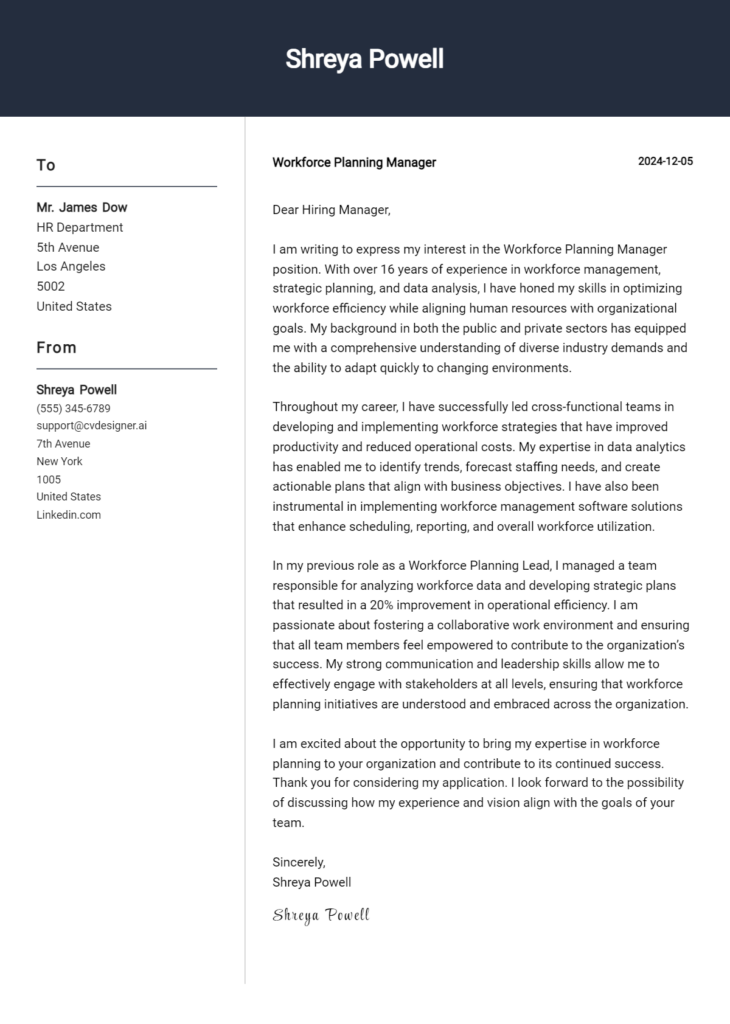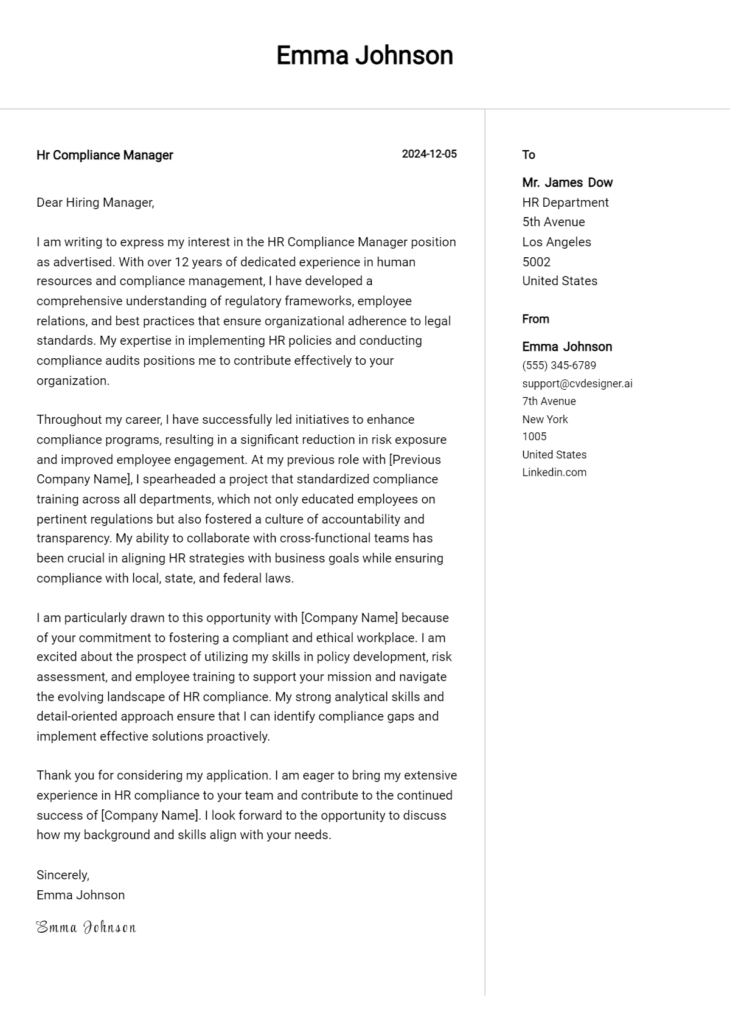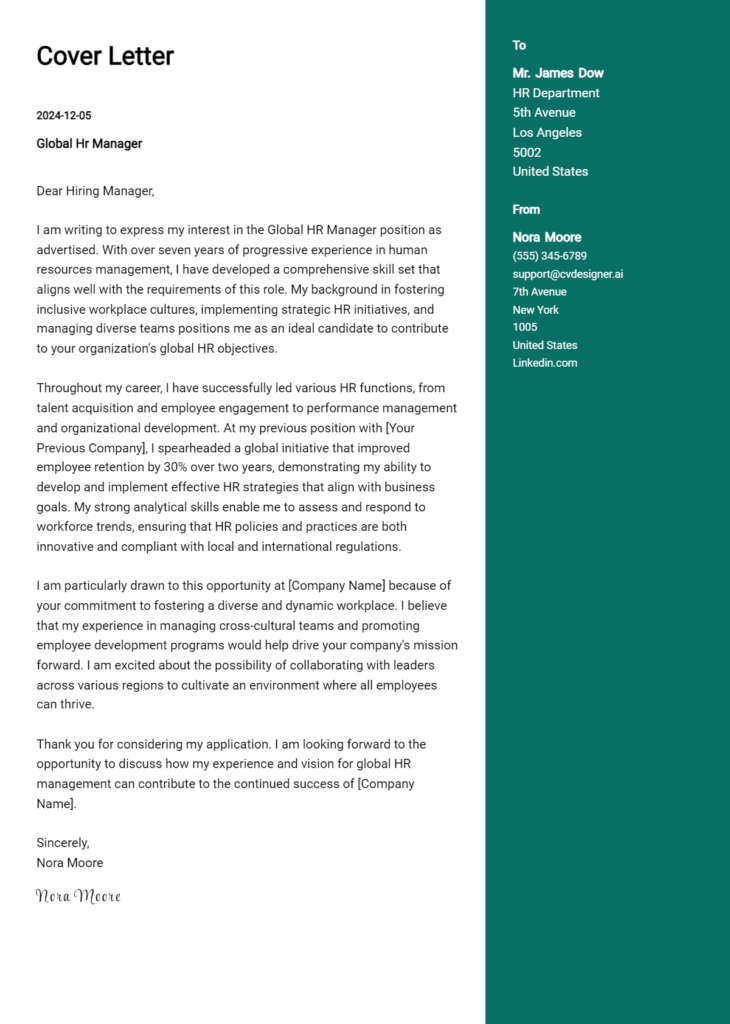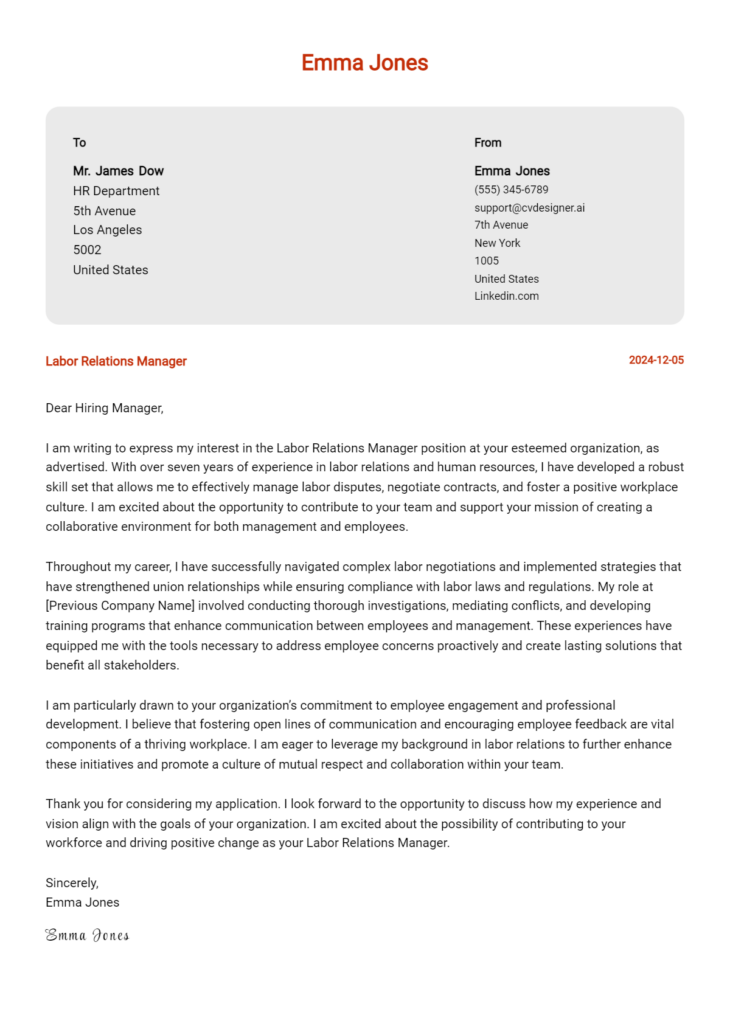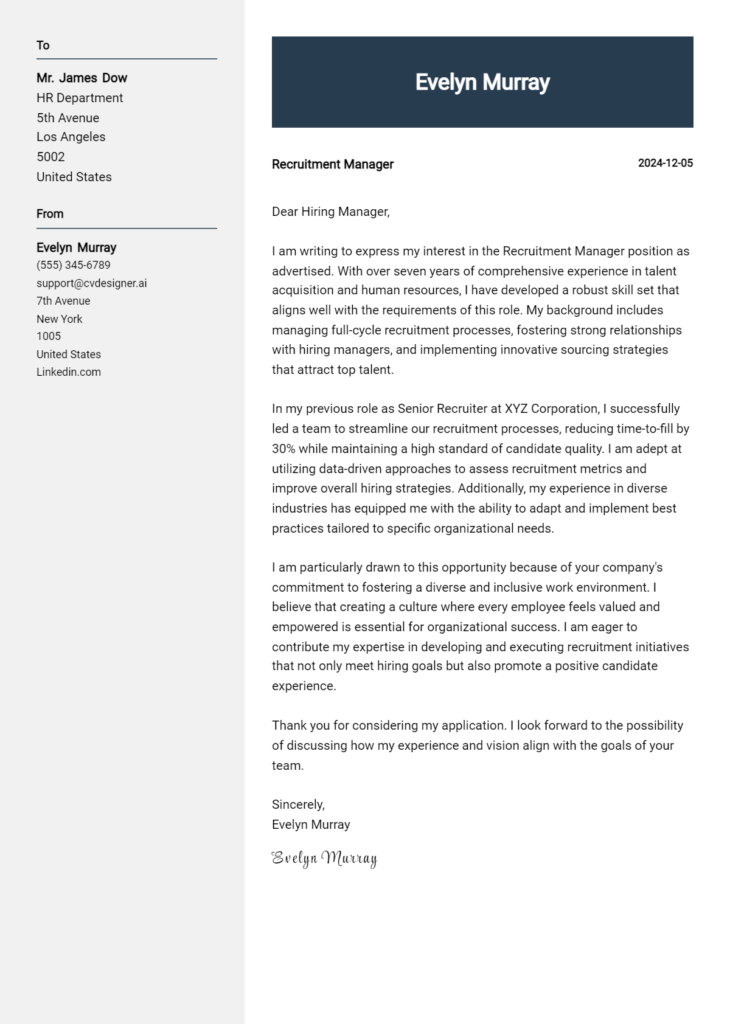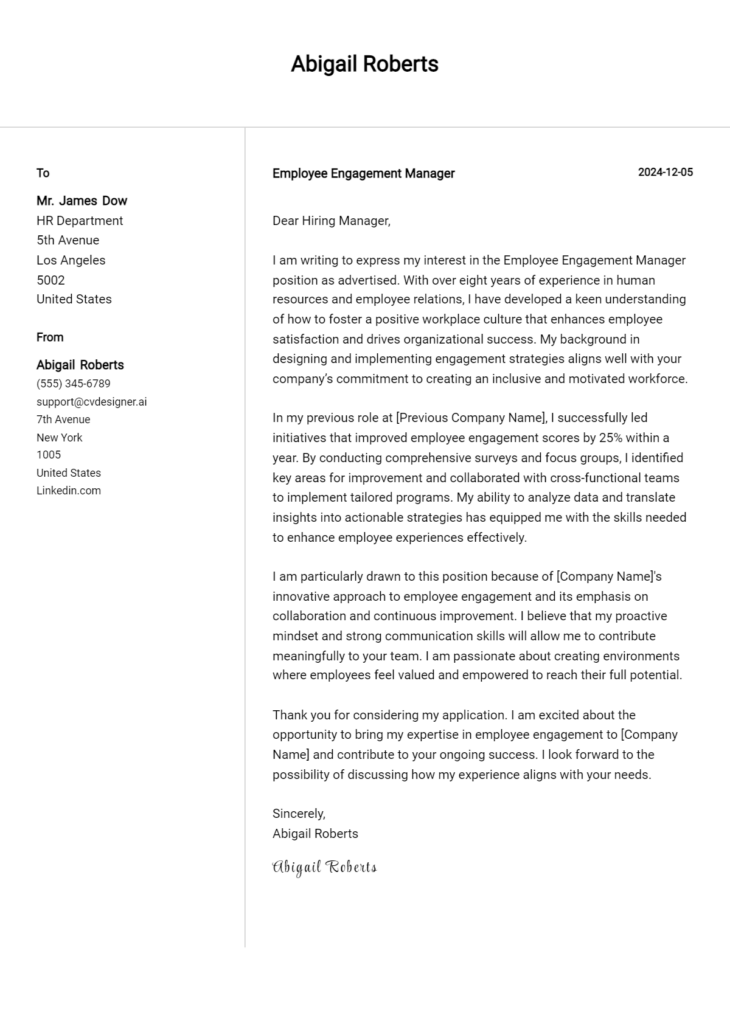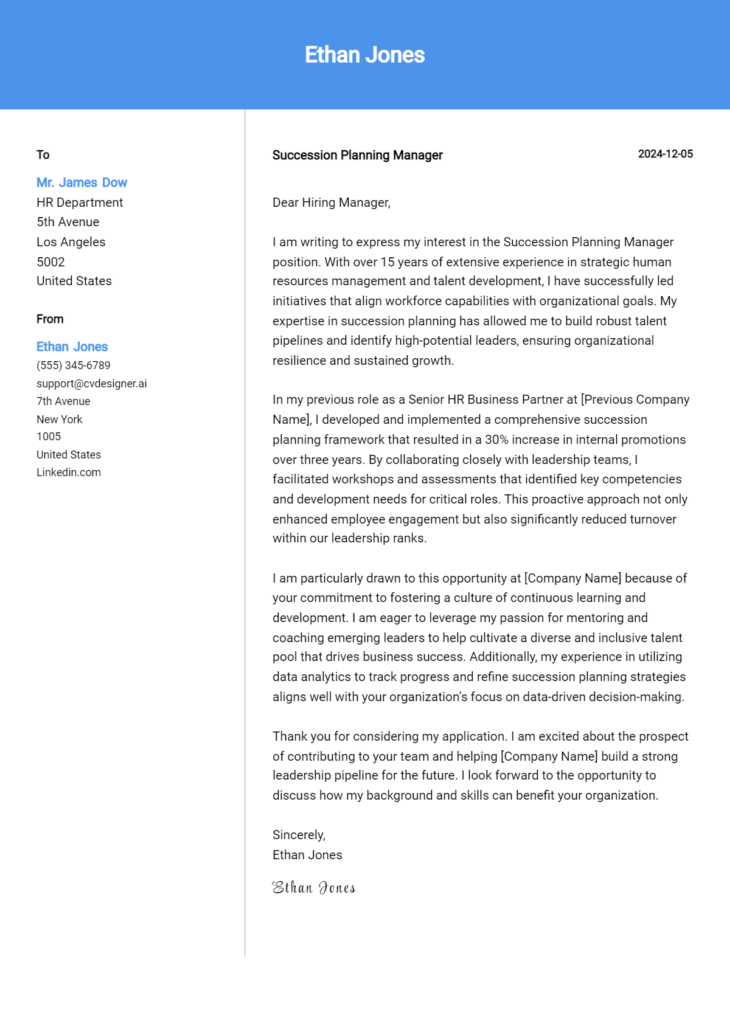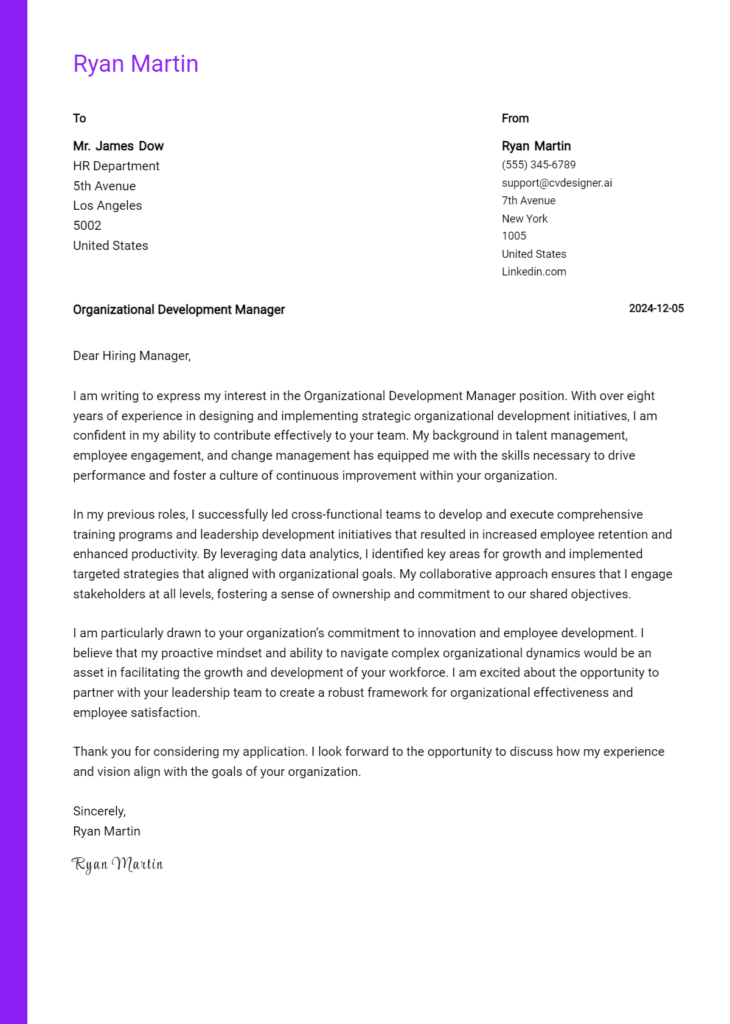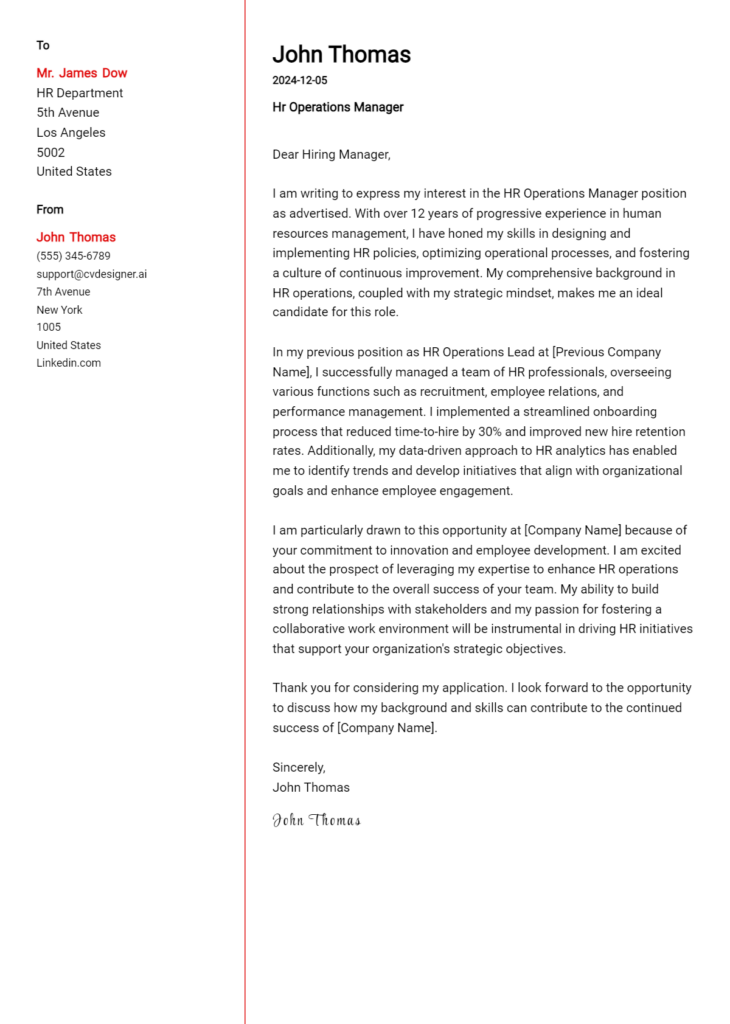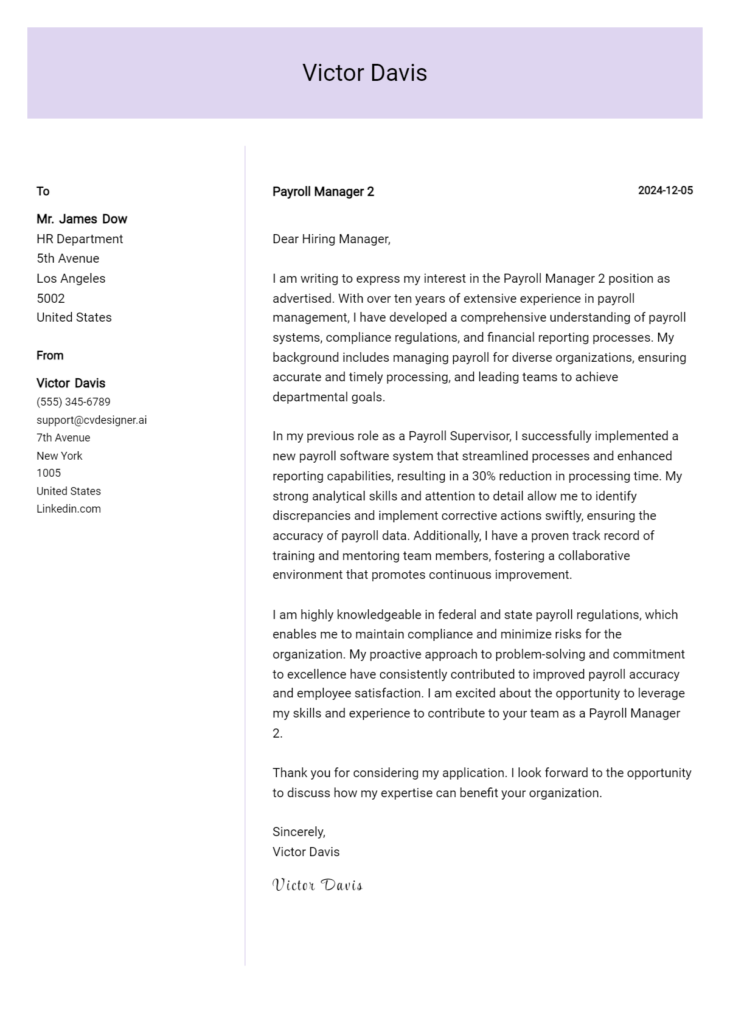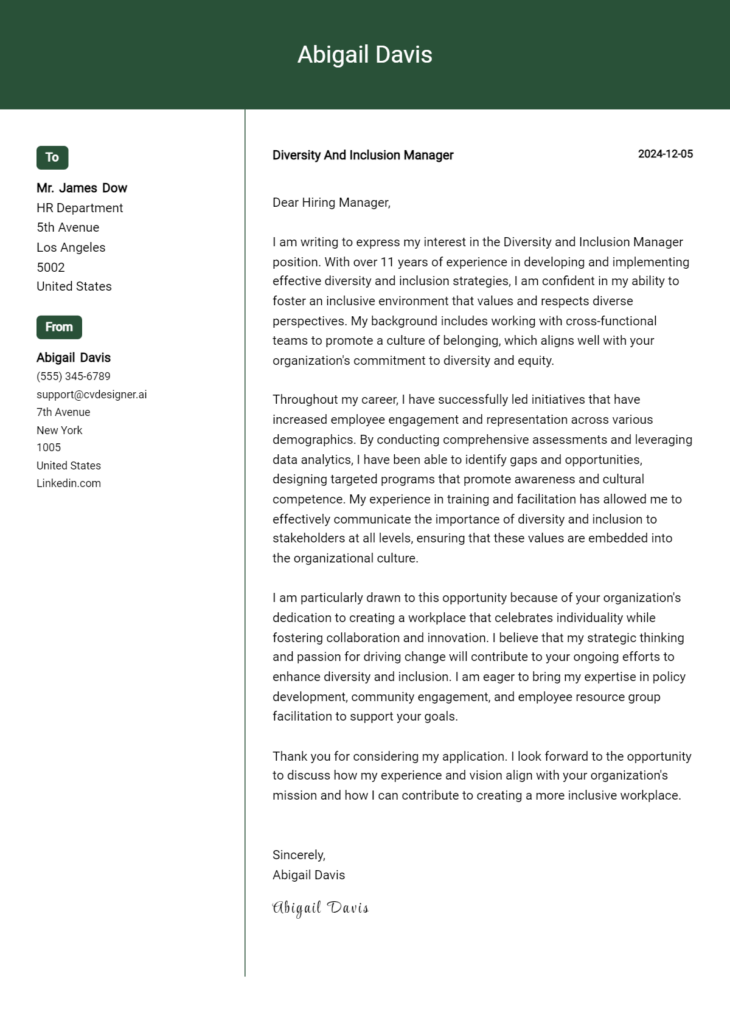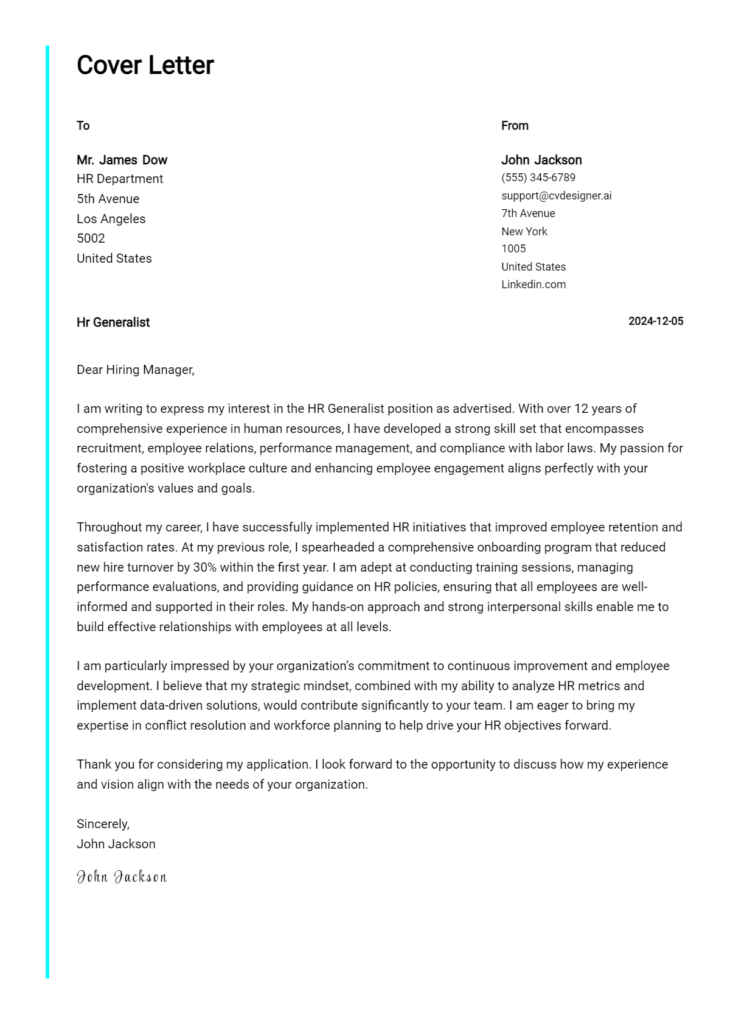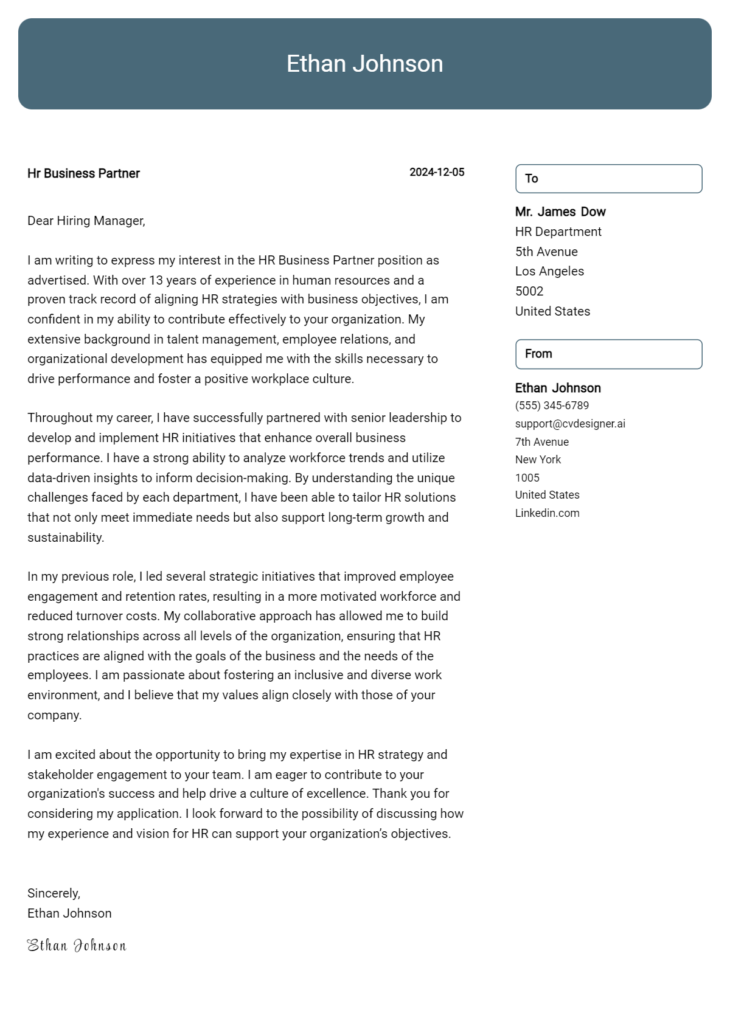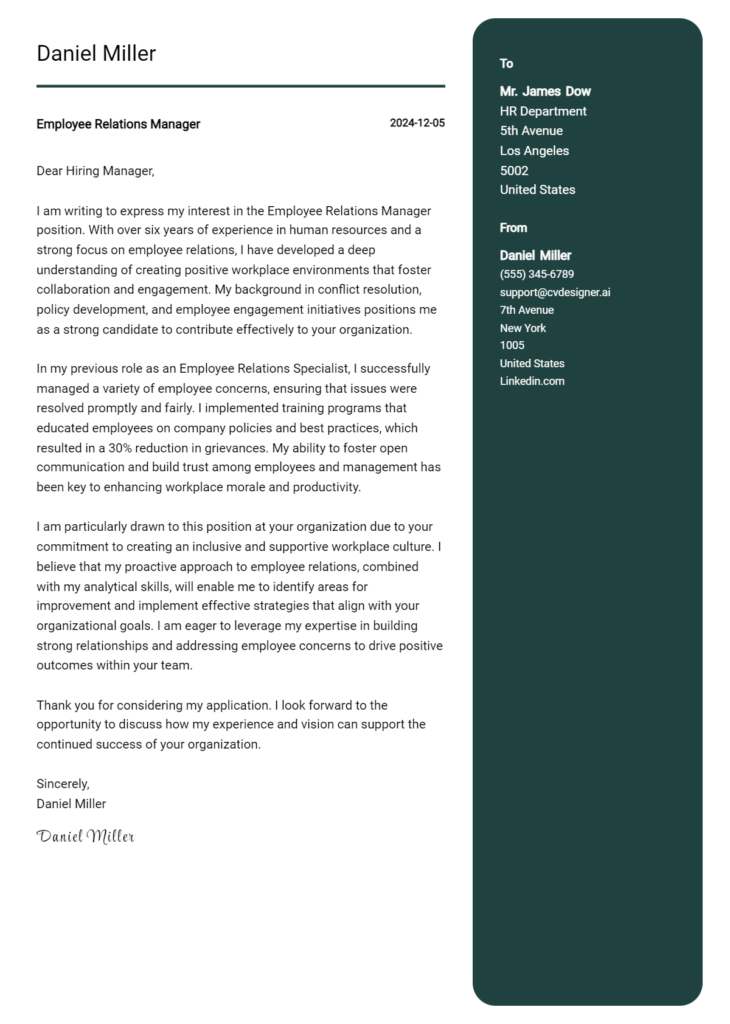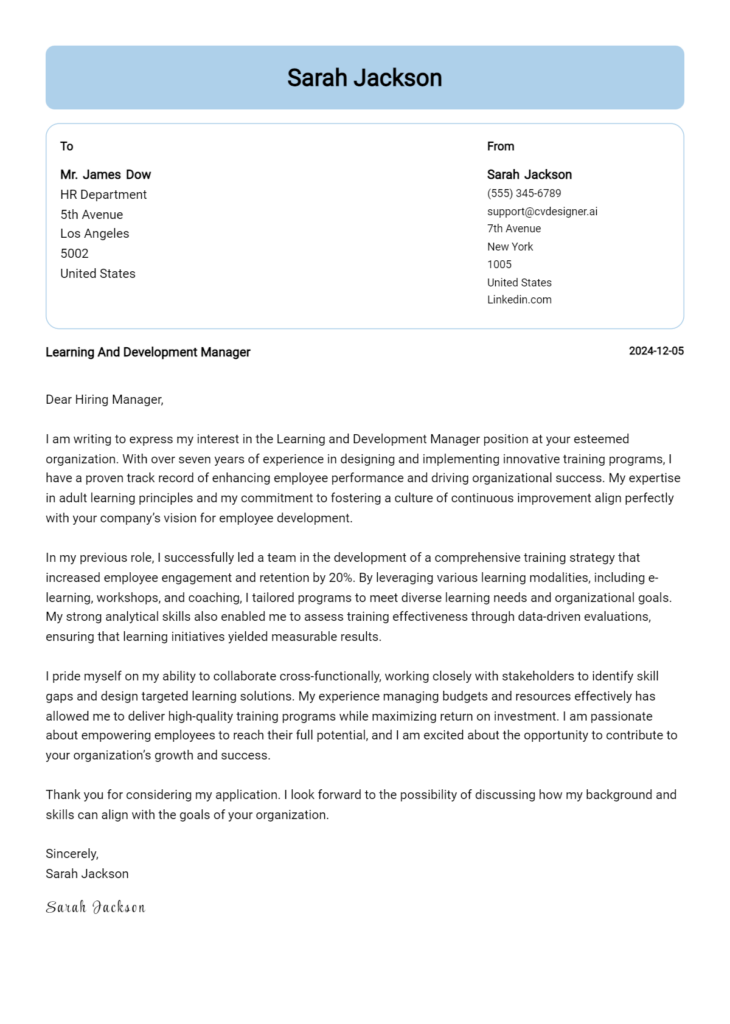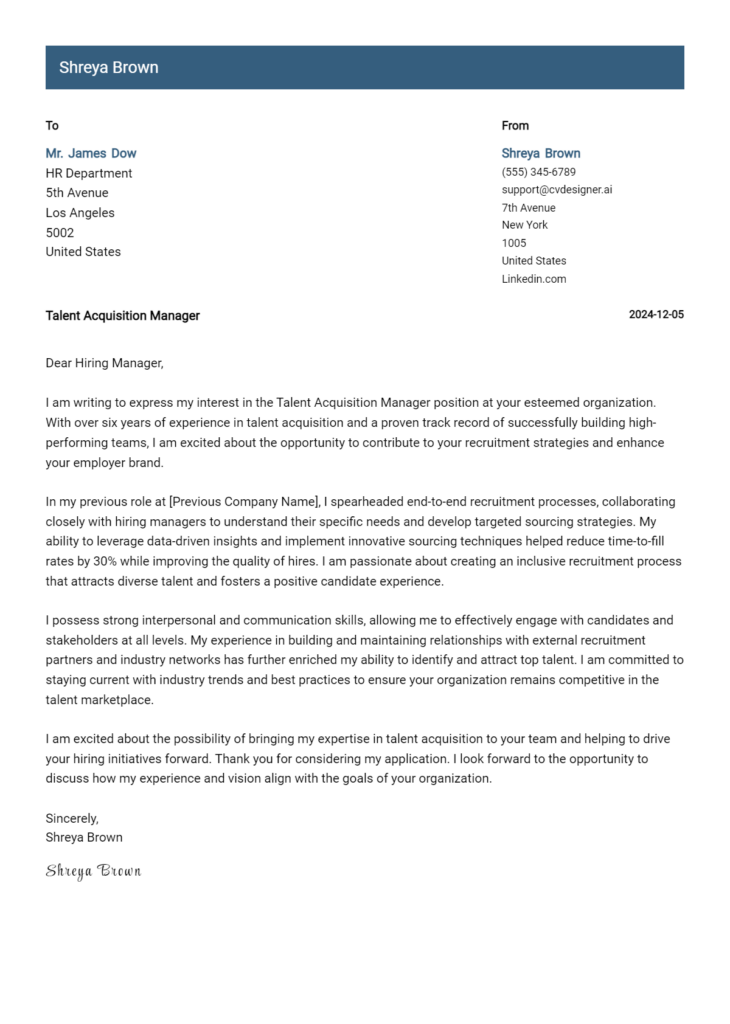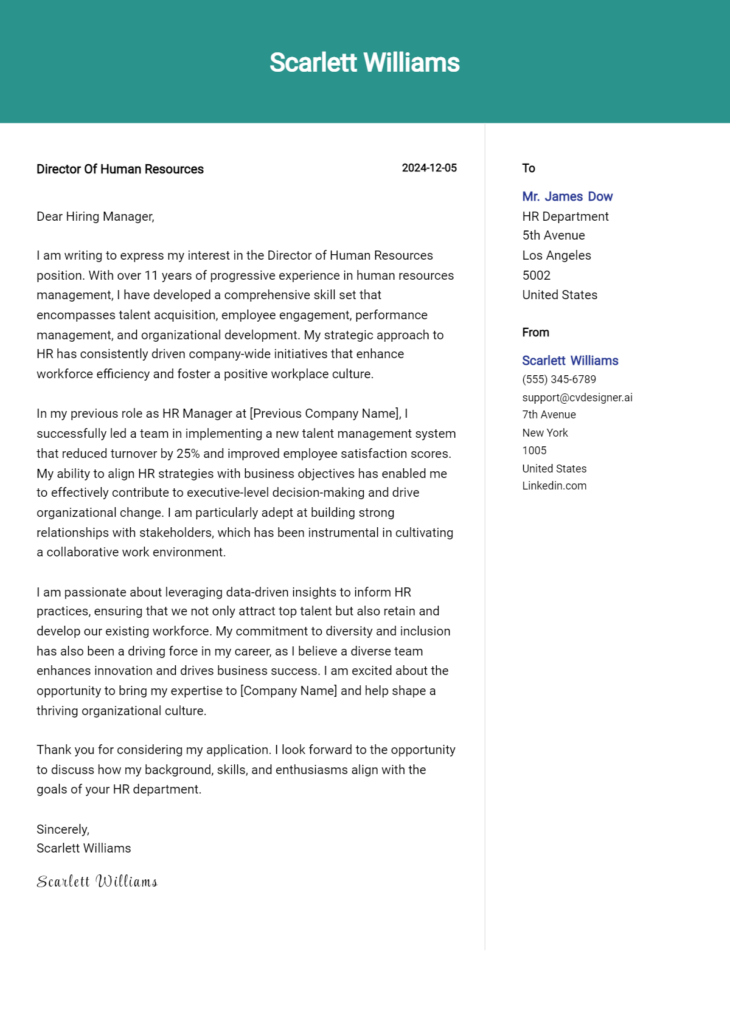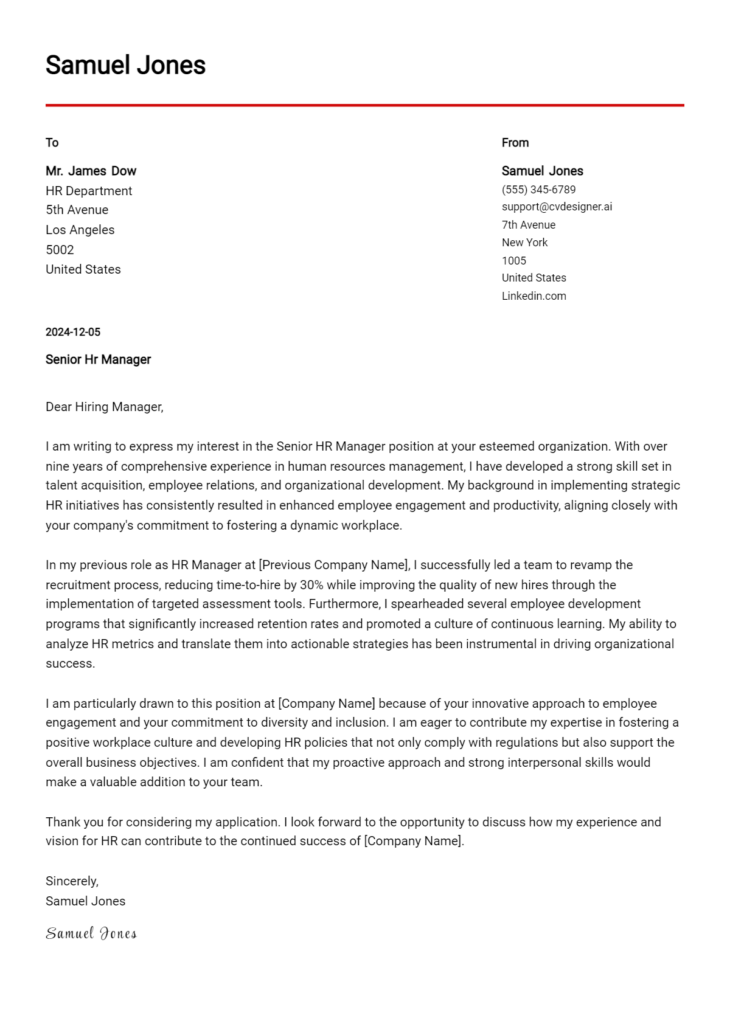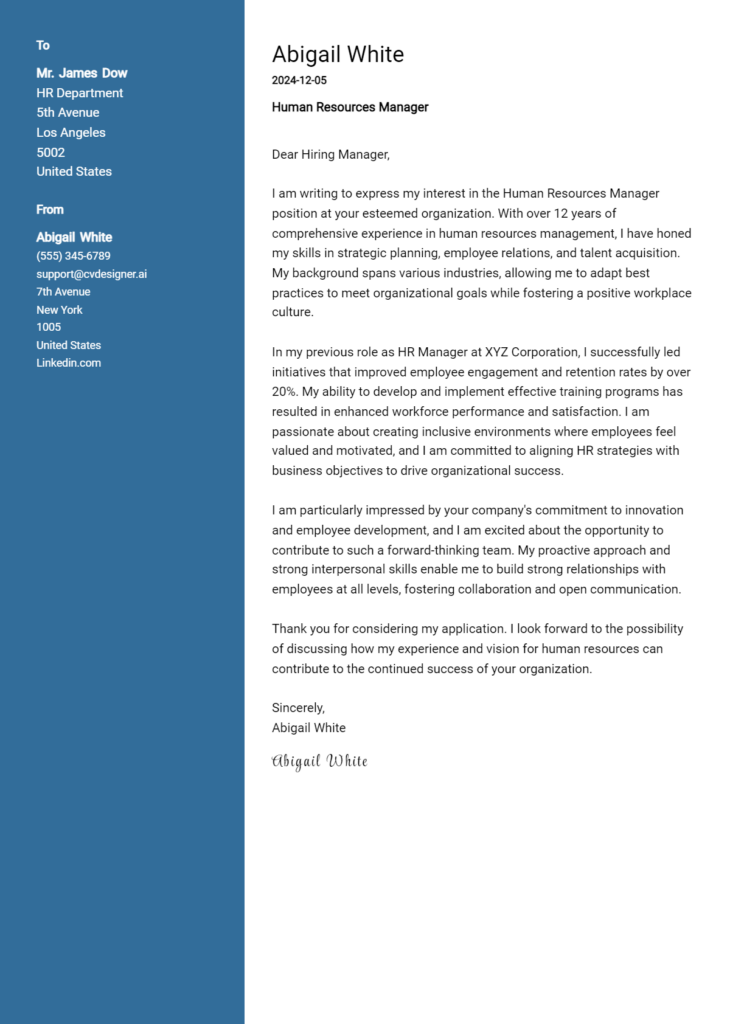Compensation And Benefits Manager Cover Letter Examples
Explore additional Compensation And Benefits Manager cover letter samples and guides and see what works for your level of experience or role.
How to Format a Compensation and Benefits Manager Cover Letter?
Crafting a compelling cover letter for a Compensation and Benefits Manager position is essential, as it not only showcases your qualifications but also highlights your understanding of the importance of employee compensation and benefits systems within an organization. The way you structure your cover letter can significantly impact how hiring managers perceive your professionalism and organizational skills—key attributes for someone in this pivotal role. A well-formatted cover letter serves as a reflection of your meticulousness and strategic thinking, which are crucial for designing effective compensation packages that attract and retain talent.
In this guide, we'll explore how to structure your cover letter, providing insights and examples specific to the Compensation and Benefits field to help you create an impressive document.
We'll focus on the essential components of a professional cover letter, including:
- Cover Letter Header
- Cover Letter Greeting
- Cover Letter Introduction
- Cover Letter Body
- Cover Letter Closing
Each section plays a crucial role in showcasing your expertise and professionalism. Let’s break down each part and explain how to make your cover letter stand out in the competitive landscape of compensation and benefits management.
Importance of the Cover Letter Header for a Compensation and Benefits Manager
The cover letter header serves as the first impression for potential employers, setting the tone for the entire application. For a Compensation and Benefits Manager, clarity and professionalism are paramount, as these qualities reflect the candidate's attention to detail and organizational skills—key attributes in this role. A well-structured header should include the applicant's contact information, the date of submission, and the recipient's details, ensuring that all relevant parties can be easily identified. This not only enhances readability but also demonstrates a level of professionalism that is crucial in human resources roles.
Strong Example
Jane Doe 123 Main Street City, State, Zip jane.doe@email.com (123) 456-7890 October 15, 2023 Mr. John Smith Hiring Manager XYZ Corporation 456 Corporate Ave City, State, Zip
Weak Example
jane_doe@email.com 10/15/23 XYZ Corp
The Importance of a Cover Letter Greeting for a Compensation and Benefits Manager
The greeting of your cover letter is a crucial component that sets the tone for the entire correspondence. A well-crafted greeting not only demonstrates professionalism but also shows a level of personalization that can help you stand out from other candidates. By addressing the hiring manager directly, you establish a connection that can create a positive first impression. It is essential to avoid generic greetings like "To Whom It May Concern" as they can come across as impersonal and indifferent. Instead, take the time to research and find the recipient's name, which can significantly enhance the impact of your greeting.
Strong Greeting Example
Dear Ms. Johnson,
Weak Greeting Example
To Whom It May Concern,
By following these tips, you can ensure that your cover letter greeting effectively captures attention and sets a professional tone for the remainder of your application.
The Importance of an Engaging Cover Letter Introduction for a Compensation and Benefits Manager
A well-crafted cover letter introduction is crucial for a Compensation and Benefits Manager, as it serves as the first impression a candidate makes on the hiring manager. This opening paragraph should not only capture the reader's attention but also convey the candidate's enthusiasm for the position while briefly highlighting relevant skills and achievements. A strong introduction can set the tone for the entire cover letter, showcasing the candidate's understanding of the role and their passion for optimizing employee compensation and benefits, which are essential for attracting and retaining top talent. Below are examples of both strong and weak cover letter introductions tailored for this role.
Strong Example
Dear [Hiring Manager's Name], I am excited to apply for the Compensation and Benefits Manager position at [Company Name], as I am passionate about creating innovative compensation strategies that enhance employee satisfaction and drive organizational success. With over 7 years of experience in human resources, specializing in compensation analytics and benefits administration, I have successfully implemented programs that increased employee retention by 15% and streamlined benefits processes, resulting in a 20% cost reduction. I am eager to bring my expertise in data-driven decision-making and strategic planning to your esteemed team.
Weak Example
To Whom It May Concern, I am writing to apply for the Compensation and Benefits Manager position. I have some experience in HR and think I would be a good fit. I have worked in various roles and have done a few things related to compensation and benefits, but I am not sure how much impact I have had. I would like to discuss my qualifications further with you.
Purpose of the Cover Letter Body for a Compensation and Benefits Manager
The cover letter body for a Compensation and Benefits Manager plays a crucial role in articulating the candidate's qualifications and how they align with the company's goals. This section allows candidates to showcase their relevant skills and experiences, demonstrating their ability to design effective compensation structures and benefits programs. By highlighting specific projects or accomplishments—such as successful implementation of a new pay structure that improved employee satisfaction or a comprehensive benefits review that resulted in cost savings—the candidate can convey their value to the organization. This not only provides evidence of their capabilities but also illustrates their proactive approach to addressing the needs of both the employees and the company.
Strong Example
Dear Hiring Manager, In my previous role as a Compensation and Benefits Specialist at XYZ Corporation, I successfully led a project to revamp our employee benefits program, which resulted in a 25% increase in employee engagement scores. By conducting comprehensive market analysis and employee surveys, I was able to identify key areas for improvement and implement changes that aligned our offerings with industry standards. Additionally, I developed a new performance-based compensation model that increased productivity by 15% within the first year. My proven ability to analyze data and create solutions tailored to employee needs will be an asset to your team as we strive to enhance our compensation strategies at ABC Company. Sincerely, John Doe
Weak Example
Dear Hiring Manager, I have worked in HR for several years and have some experience with compensation and benefits. I think I could do a good job at your company. In my last job, I helped with some projects, but I didn’t really lead them. I understand that benefits are important, and I know how to look at data. I hope to bring my skills to your team. Best, John Doe
Importance of Cover Letter Closing for a Compensation and Benefits Manager
The closing paragraph of a cover letter serves as a critical opportunity to reinforce your qualifications, express enthusiasm for the position, and prompt the hiring manager to take the next steps, such as reviewing your resume or scheduling an interview. A strong closing will leave a lasting impression and convey your eagerness to contribute to the organization, while a weak closing may fail to express your interest or confidence in your abilities.
Strong Example
Thank you for considering my application for the Compensation and Benefits Manager position. With over eight years of experience in designing competitive compensation structures and managing employee benefits programs, I am excited about the opportunity to bring my expertise to your team. I am passionate about fostering an equitable workplace and would love to discuss how my background aligns with the goals of your organization. I look forward to the possibility of discussing my application further and am available for an interview at your convenience.
Weak Example
I hope you like my application. I have some experience in compensation and benefits, and I think I would be okay for the job. Please let me know if you want to talk. Thanks.
These tips will assist candidates in crafting an effective cover letter for the role of a Compensation and Benefits Manager. In this position, it is crucial to demonstrate a strong understanding of technical skills, problem-solving abilities, knowledge of the software development life cycle (SDLC), teamwork, and a commitment to continuous learning. A well-structured cover letter can set you apart from other applicants and highlight your qualifications.
Cover Letter Writing Tips for Compensation and Benefits Manager
Showcase Relevant Technical Skills
Begin your cover letter by highlighting your technical skills related to compensation and benefits management. Mention specific software or tools you are proficient in, such as HRIS systems, payroll software, or data analysis tools. This will demonstrate your ability to manage complex compensation structures and analyze benefits programs effectively.Emphasize Problem-Solving Abilities
Compensation and Benefits Managers often face unique challenges. Use specific examples from your career where you successfully resolved issues related to employee compensation or benefits administration. This could include examples of how you improved existing processes or developed innovative solutions to enhance employee satisfaction and retention.Highlight Knowledge of SDLC
Understanding the software development life cycle is increasingly important in this role, especially if you are involved in implementing HR technologies. Describe your experiences with project management and how you have contributed to the development and deployment of systems that streamline compensation and benefits processes.Demonstrate Teamwork and Collaboration
The ability to work effectively with other departments, such as finance and HR, is crucial for a Compensation and Benefits Manager. Highlight instances where you collaborated with teams to implement compensation strategies or benefits programs. This shows that you can foster positive relationships and work towards common organizational goals.Express a Passion for Continuous Learning
The field of compensation and benefits is constantly evolving. Showcase your commitment to continuous learning by mentioning any relevant certifications, courses, or workshops you’ve completed. Discuss how staying updated on industry trends and regulations enables you to make informed decisions that benefit both employees and the organization.
For additional inspiration, consider exploring cover letter templates or utilize a cover letter builder to streamline the writing process. A well-crafted cover letter will enhance your chances of securing an interview for this vital role.
Common Mistakes to Avoid in a Compensation and Benefits Manager Cover Letter
Crafting a compelling cover letter is crucial for standing out in the competitive field of Compensation and Benefits Management. Avoiding common mistakes can significantly enhance your chances of landing an interview. Here are some pitfalls to watch out for:
Generic Content: Failing to tailor your cover letter to the specific job can make it seem impersonal. Research the company and incorporate relevant details to demonstrate your fit for the role.
Ignoring Job Requirements: Not addressing the key qualifications listed in the job description can be detrimental. Use the cover letter to highlight how your experience aligns with the required skills.
Poor Formatting: A cluttered or unprofessional layout can detract from your message. Follow a clear cover letter format to ensure readability and professionalism.
Overly Formal Language: Using overly formal or complicated language can create distance. Aim for a conversational yet professional tone that reflects your personality.
Neglecting to Showcase Achievements: Simply stating your responsibilities without illustrating achievements can weaken your case. Quantify your accomplishments to provide concrete evidence of your impact.
Not Proofreading: Spelling and grammatical errors can undermine your credibility. Always proofread your cover letter before submission or use tools to check for mistakes.
Failing to Include a Call to Action: Concluding without a clear call to action may leave the reader uncertain about your enthusiasm. End with a strong statement expressing your desire for an interview or further discussion.
By avoiding these common mistakes and following best practices, you can create a compelling cover letter that sets you apart from the competition. For more inspiration, check out these cover letter examples.
Cover Letter FAQs for Compensation and Benefits Manager
What should I include in my cover letter for a Compensation and Benefits Manager position?
In your cover letter, you should highlight your expertise in compensation strategies, benefits administration, and compliance with regulations. Begin with a strong introduction that states your interest in the position and briefly outlines your professional background. Include specific examples of your achievements, such as implementing compensation structures or improving employee satisfaction through benefits programs. Address your familiarity with HRIS systems, data analysis, and market research to emphasize your analytical skills. Finally, express your enthusiasm for the company's mission and how you plan to contribute to their goals in compensation and benefits.
How can I demonstrate my qualifications for the Compensation and Benefits Manager role?
To effectively demonstrate your qualifications, focus on quantifiable results from your previous roles. Use metrics to showcase your impact, such as the percentage of reduced turnover rates due to better benefits or the successful implementation of a new pay structure that aligned with industry standards. Mention relevant certifications such as Certified Compensation Professional (CCP) or Professional in Human Resources (PHR). Additionally, discuss your experience with talent acquisition and retention strategies that complement compensation and benefits initiatives. This will paint a comprehensive picture of your ability to drive organizational success.
Should I tailor my cover letter for each job application?
Absolutely! Tailoring your cover letter for each job application is crucial in making a strong impression. Research the specific organization and its culture, and align your skills and experiences with their requirements. Use keywords from the job description to demonstrate that you understand the nuances of the role and how you can meet their needs. This personalized approach not only shows your genuine interest in the position but also helps you stand out among other candidates who may submit generic applications. Customizing your cover letter can significantly increase your chances of being noticed.
How do I address gaps in my employment history in my cover letter?
If you have gaps in your employment history, address them briefly and positively in your cover letter. Focus on what you learned or accomplished during that time, whether it was furthering your education, volunteering, or pursuing personal projects related to your profession. Emphasize any skills or insights gained that can benefit the employer in the Compensation and Benefits Manager role. Acknowledge the gaps without dwelling on them, and pivot back to your qualifications and enthusiasm for the position. This approach demonstrates resilience and a proactive attitude, which employers appreciate.
Build your Cover Letter in minutes
Use an AI-powered cover letter builder and have your letter done in 5 minutes. Just select your template and our software will guide you through the process.



